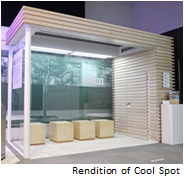Tokyo/Osaka, August 19, 2015 - Panasonic Corporation and Mori Building announced today that they will launch a series of collaborative field experiments at Mori's various Hills facilities in Tokyo to test new urban technologies and solutions. The aim is to develop and confirm innovative solutions that provide increased comfort and convenience for foreign visitors to Tokyo, who are expected to reach some 20 million by 2020.
As the number of foreign visitors to Tokyo steadily rises, Mori's Hills facilities and other major tourism spots are working on challenges such as providing protection from summer heat and arranging more foreign-language services. Meanwhile, Panasonic is looking to accelerate the development of innovative solutions to meet these challenges. Together, Panasonic and Mori Building will now implement a number of field experiments at Mori's iconic Hills facilities to test the usability of various related technologies and solutions.
Mori's Hills facilities, known as "cities within cities," provide ideal environments for real-life field experiments of products and services expected to be incorporated in cities in the coming future.
Cool Spots at Toranomon Hills
 Panasonic's Cool Spot solution will be tested from August 27 at Toranomon Hills, Mori's latest multi-use high-rise building. The Cool Spot is a micro-thermal environment created with mist, air curtains and light-blocking panels to help people avoid heat stroke. Panasonic is also aiming to add moisture-capturing blocks to the Cool Spot to help efficiently reduce the overall temperature inside, as well as a stand-alone power system consisting of solar panels and a storage battery. The company will utilize the findings from this experiment in developing future products.
Panasonic's Cool Spot solution will be tested from August 27 at Toranomon Hills, Mori's latest multi-use high-rise building. The Cool Spot is a micro-thermal environment created with mist, air curtains and light-blocking panels to help people avoid heat stroke. Panasonic is also aiming to add moisture-capturing blocks to the Cool Spot to help efficiently reduce the overall temperature inside, as well as a stand-alone power system consisting of solar panels and a storage battery. The company will utilize the findings from this experiment in developing future products.
Automatic multi-language interpretation devices at Roppongi Hills and VenusFort
From September, Panasonic's automatic multi-language interpretation device will be tested in field experiments at Roppongi Hills and VenusFort, the two Hills facilities visited most frequently by foreign visitors. By offering the devices at information desks, Panasonic will be able to confirm their appeal and functionality for users while also identifying areas for improvement.
About Mori Building
Tokyo-based Mori Building Co., Ltd. creates groundbreaking concepts for urban living throughout Japan and the rest of Asia. As one of Japan's leading urban landscape developers, Mori Building engages in urban redevelopment, real estate leasing and management, and consultation for leisure complexes, offices and high-class residences. Two of its most noted developments are the Roppongi Hills complex in Tokyo and the Shanghai World Financial Center. Mori Building was established in 1959. Visit: http://www.mori.co.jp/en/
About Panasonic
Panasonic Corporation is a worldwide leader in the development of diverse electronics technologies and solutions for customers in the consumer electronics, housing, automotive, enterprise solutions and device industries. Since its founding in 1918, the company has expanded globally and now operates 468 subsidiaries and 94 associated companies worldwide, recording consolidated net sales of 7.715 trillion yen for the year ended March 31, 2015. Committed to pursuing new value through innovation across divisional lines, the company uses its technologies to create a better life and a better world for its customers. To learn more about Panasonic: http://www.panasonic.com/global
Inquiries from international media
- Mori Building
- Rutsuko Nakajima or Masashi Nonaka, Weber Shandwick
- Tel: +81-90-9006-2769/+81-80-1037-7879
- Email: moribldg@webershandwick.com
- Panasonic
- Public Relations Department
- Tel: +81-3-3574-5664 Fax: +81-3-3574-5699






